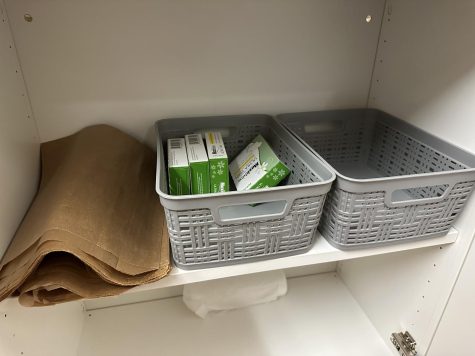Improve menstrual products available in restrooms. Period.

The feminine hygiene products at school aren’t exceedingly useful at times when they’re needed the most. SPA needs to reevaluate the chosen feminine hygiene products – and the metrics used to choose them – and here’s why.
There are three main products in the bathrooms: Tampax tampons, Guards, and Maxithins. They’re fairly recognizable, all in tidy, individual packaging, located in a plastic grey bin inside of the sleek white cabinets in every women’s and gender-neutral restroom.
Tampax tampons. These tampons are fairly standard, the kind often found for a quarter in a general airport dispenser. Of the three products, these are the only ones I haven’t personally tried, and therefore can’t speak to their comfort or durability.
Maxithins. The Maxithins are not quite as thin as the name might suggest, but they do need to be changed several times a day. Thus the general consensus among users, including myself, is that they’re most useful on and after the third day of a menstrual cycle, as the bleeding is less heavy.
Guard pads. The most notable feature of the Guards is their lack of wings. They’re thicker than the Maxithins, though, which puts the user in an odd position: either use the Guard on the first day or two of the period and risk the sides folding in, or use them later in the cycle when their thickness is marginally less useful. Or bring some of your own pads from home, which somewhat defeats the intent of having products at school to use.
The purpose of having products are manifold: if someone starts a cycle at school or forgets their product, they don’t have to go without it, and ideally, providing products at school should mean that someone may not even have to bring their own to school either, whether as a result of period poverty or not. This is why having versatile products is of the utmost importance.
When I began, what I really wanted to know was how the products were chosen, where they are ordered from, what the school’s budget for these products looks like, and if any other options have been considered recently or in the past.
Melissa Douden, SPA’s accounting assistant and transportation coordinator to whom I reached out, was able to answer one of my queries via email: “We order products through our paper supplier – they also provide our toilet paper and paper towels, etc.” Douden said the options that are chosen are selected for their vendibility; in short, if they will dispense well. This is peculiar given that we don’t have dispensers.
The questions about how much funding is budgeted for period products was not disclosed.
Time to do a little bit of investigative math to get an approximate estimate of how much is spent, as I am nothing if not obstinate.
Let’s assume that one basket can fit about 10 boxes of Maxithins, 10 boxes of Guards, and 70 tampons. There are eighteen bathrooms with these baskets around the school, which means there are around 1,260 tampons and 180 Guards and Maxithins. A box of 100 tampons seems to be, give or take, around $21. 250 of the Guards can be acquired for $64, and 250 of the Maxithins are around $49. (Estimations may not be completely precise, as they are from Amazon). This means that both an individual tampon and an individual Maxithin are valued at two cents, and a Guard is valued at three. Multiply the individual product by the amount per bathroom, and then again per the number of restrooms, and the grand total amounts to about $252 dollars worth of Tampax, $648 dollars worth of Maxithins, and $378 worth of Guards. Though I don’t know how often the bathrooms are restocked and therefore cannot say approximately how much of each item is purchased throughout the year, the sum of the three products puts the school at a minimum budget of $1278. Rounded up, $1300 seems to be around the cost of keeping all the bathrooms fully stocked at any given time.
Keep the tampons but invest in one kind of pad that is versatile enough to be useful for different situations. A pack of medium-sized, winged, not-extra-thin pads rather than two different kinds would be much more convenient. For example, a pack of 42 size two Always pads is about $8, putting the individual pads between a value of $0.2-0.3 – matching the value of the Maxithins. By investing in one brand of pads that are of better quality, the school will save money and maximize the usefulness of the products.
All this being said: it is a fantastic service that we have products at school for free use. There are schools out there that don’t offer such amenities. That this piece discusses product quality and not access is wonderful. However, knowing that we are privileged enough to have products at school, it’s important to set criteria that make the most of products available in the market. Vendebility should not be a concern; good products can easily be purchased within the estimated budget range.
In order to optimize the usefulness of the products and the satisfaction of the users, Operations needs to consider other options for feminine hygiene products in the bathrooms.
Aarushi Bahadur (she/her) is an avid record collector. Her interest in vinyl began when she picked up a Til Tuesday record from a secondhand bookshop...